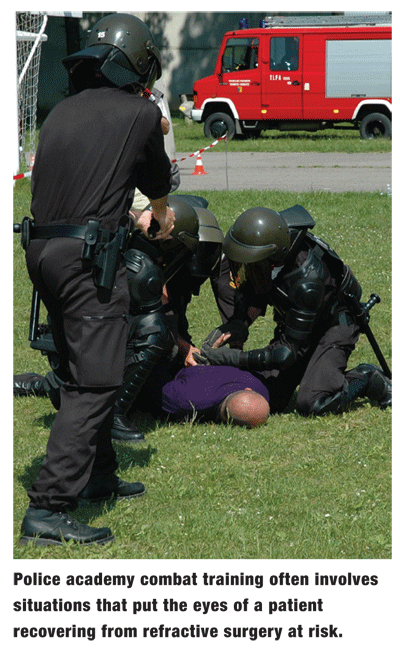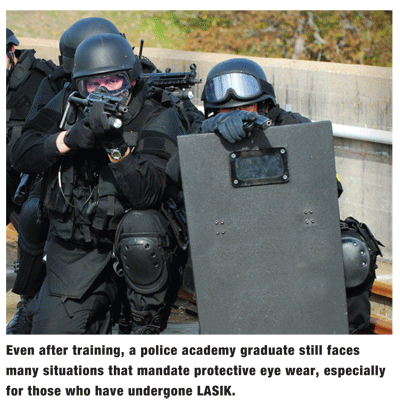 Q: I have a 21-year-old patient who hopes to enter the
Q: I have a 21-year-old patient who hopes to enter the
A: This case presents two conflicting concerns: Will the patients visual acuity improve quickly enough and to the level required to enter the police academy? And, how can he minimize the risk of injury from hand-to-hand combat or exposure to pepper spray?
Make sure the patient is aware that with any refractive surgery, visual acuity may not improve to a level that satisfies the academys entrance requirements.  Once the patient understands this risk, there are several factors to consider in choosing the most appropriate procedure.
Once the patient understands this risk, there are several factors to consider in choosing the most appropriate procedure.
Laser-assisted in situ keratomileusis (LASIK), with its normally predictable and swift recovery, may initially draw the patients interestand possibly clear him for entry into the academy earlier than photorefractive keratectomy (PRK) or other non-lamellar procedures.
But, LASIK also poses some potentially severe risks for the patient involved in police academy training. Specifically, the corneal flap created during LASIK can become dislocated following minor physical trauma, such as a finger or object striking the eye. If the flap becomes dislocated, the patient would require further medical or surgical intervention to correct the dislocation and protect the patients vision.1
We will do LASIK on a patient who will enter the police academy, but I would give a significant caution of possible injury and would mandate the use of eye protection in a post-LASIK patient during any training involving hand-to-hand combat, says Louis Phillips, O.D., of  e of the risks associated with LASIK, he adds.
e of the risks associated with LASIK, he adds.
A foreign object or force would have to combine with sufficient pressure and catch the flap at a specific angle to cause dislocation or other flap injury, says J. James Thimons, O.D., of Fairfield, Conn. Although there is only an extremely minimal risk of a glancing blow that would catch the flap, if the patient is engaging in any activity where there is frequent facial contact, I would recommend Epi-LASIK or PRK, he adds.
LASIK flap dislocations have been shown to occur in a minority of cases up to seven years after surgery.2 There would be a risk to this patient in the course of day-to-day police activity even after he has completed academy training. So, it is in the patients best interest to explore other options. Typically, if somebody is in a combat or high-contact situation, PRK or another non-lamellar procedure would better maintain structural stability [of the cornea], Dr. Thimons says.
But, the recovery of visual acuity after surface ablation, such as PRK or laser epithelial keratomileusis (LASEK), is much slower than that post-LASIK. Patients who receive PRK or LASEK may take weeks or months to achieve their full results, and many patients experience corneal haze, glare and haloes during recovery. If this patient undergoes surface ablation, he may have to delay entrance into the academy for anywhere from six to nine months.3
The use of pepper spray in police academy training raises further concerns for a post-LASIK patient. While visual acuity and corneal sensitivity can be maintained in LASIK patients after exposure to pepper spray (oleoresin capsicum), there is some evidence of late-onset diffuse lamellar keratitis (DLK) caused when foreign irritants become trapped beneath the corneal flap.2,4-5
Because PRK and LASEK do not require creation of a corneal flap, patients who undergo these procedures are at less risk for complications following ocular exposure to pepper spray or other irritants.
The bottom line: In this particular situation, LASIK poses significantly more risks than benefits. Essentially, you must put the patients best long-term interest and future safety ahead of his eagerness to enter training and his consequent need for quick recovery. Assure the patient that while options such as PRK and LASEK may delay his entry into the police academy, they can ultimately protect him from career-threatening complications.
1. Lombardo AJ, Katz HR. Late partial dislocation of a laser in situ keratomileusis flap. J Cataract Refract Surg 2001 Jul;27(7):1108-10.
2. Cheng AC,
3. Leccisotti A. Laser-assisted subepithelial keratectomy (LASEK) without alcohol versus photorefractive keratectomy (PRK). Eur J Ophthalmol 2003 Oct;13(8):676-80.
4. Hand D, Chotiner B. Maintenance of visual acuity after exposure to oleoresin capsicum spray following LASIK. J Refract Surg 2002 May-Jun;18(3):293-4.
5. Kocak I, Karabela Y, Karaman M, Kaya F. Late onset diffuse lamellar keratitis as a result of the toxic effect of Ecballium elaterium herb. J Refract Surg 2006 Oct;22(8):826-7.

